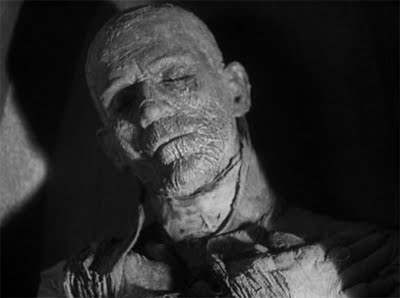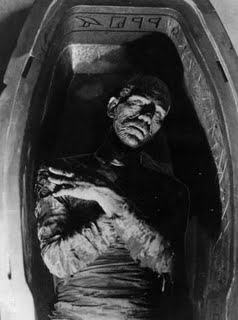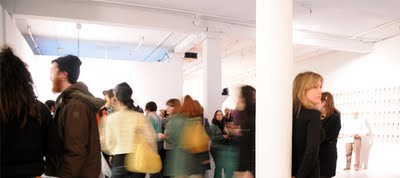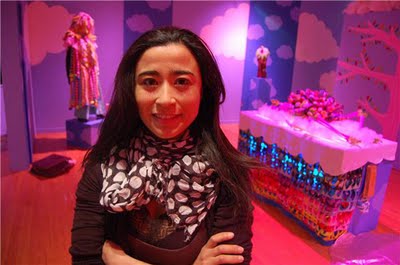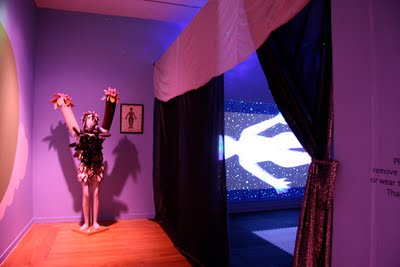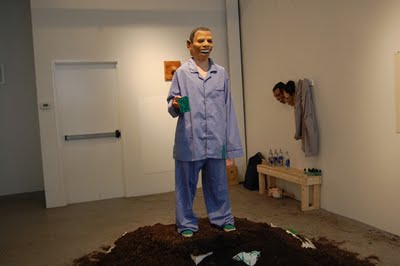
Is it all about the money?
That’s what Boston artist and critic Franklin Einspruch suggests in his thoughtful March 25 post
"Yokelism with your wallet out" at his blog Artblog.net, arguing that the fundamental problem with the Boston art scene,
the reason it continues to be stuffy and square, is that Bostonians don’t buy art.
[
Correction: We are ashamed to admit that we carelessly put words into Mr. Einspruch's mouth in the original version of this post. As he notes in his comment below, "I don't find the Boston art scene stuffy or square in the least." In fact, it is we at The New England Journal of Aesthetic Research who find the Boston art scene stuffy and square. Please forgive us for this crude act of projection.]
Einspruch is responding to painter, critic and Boston University teacher Dushko Petrovich’s Yokelist essay
“How to start an art revolution: A manifesto for Boston” in the March 14 Boston Globe, which proposes a top-down revolution lead by our august nonprofits – a new Harvard art degree program, new local satellite venues for the Museum of Fine Arts and Institute of Contemporary art, as well as offering grants, free tuition and housing for local art students to keep them around here after they graduate.
Einspruch has a more market-oriented approach. He suggests research be done to determine the extent of Boston collecting. He says Boston may be a better town for curating than dealing – but this may still help build artists’ and curators’ careers. He proposes linking potential collectors in the region’s tech industry with local artists working in new media, which is one of the standout sectors of Boston art and helps distinguish the town from other art communities. He calls for greater critical and curatorial attention to local comics and illustrationy art, which he notes also has lower prices which makes this work affordable to students and other beginning collectors. He calls for the creation of young collectors groups to cultivate new collectors. (Einspruch says Google only notices the group sponsored by the Copley Society, but the MFA and ICA both have such groups as well.)
Einspruch concludes, “Bostonians, and everyone else, will buy art if they see something they like and can afford. To think otherwise is to succumb to anecdote. Don't idly wish for philanthropy and state intervention - make something great and get it out there.”
Einspruch is right that Bostonians don't buy (enough local) art. He is right on in calling for study of the Boston art market to determine exactly how it's doing and seeking ways to promote distinctive clusters of locally-made art (tech, comics/illustration, I’d also include conceptual art).
But is it all about Boston collectors? Many have long noted the dearth of Boston collectors (in Providence the situation is even worse) and that major local collectors often prefer to go shopping in New York or fairs like Miami rather than buying here, even if the same work is available here.
This is part of a syndrome that you see among our major museums and media outlets – and even our artists. The ambitious folks here want to be part of the big game and correctly recognize that the big game isn’t here. So they focus their attentions elsewhere – or on art made elsewhere. Our local museums suffer from the worst sort of provincialism – they act as if any art made here is second rate just because it’s made here. And they have helped train local collectors to think this way too.
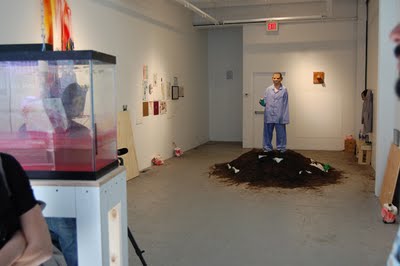
Still, you might be surprised by how challenging New England-made art can be sold here. Samson Projects in Boston made a number of sales from its recent abject, absurd installation (pictured here) by
William Pope.L of Lewiston, Maine, to local collectors as well as national and international clients. Pope.L may be an exception, as he’s already showing at major museums. But successful local galleries work hard to build a broad collector base, recognizing that a strong art business is not just dependent on local collectors.
So if we’re talking about the local market we have to also address the market for locally-made art nationally, and internationally. Which brings us back to the hurdle that, as
I’ve noted before, one of the salient characteristics of Boston’s second-city syndrome is that everyone here is convinced that everyone else here sucks. Because if they didn’t suck, they’d be in New York. And it’s going to take a lot of effort to convince folks locally and elsewhere that good art is produced here because everyone agrees with us that we suck. Which prompts another question: When was the last time that a local gallery, museum or publication helped launch a local artist onto the national scene?
But, again, how much are local gallery sales, or the lack thereof, responsible for the Boston art scene's stuffiness? Across the country there are artists who make a living substantially from selling their art (plus grants/fellowships), but most artists subsidize their art-making with other endeavors. And that’s the case here as well with artists having day jobs teaching, working in galleries or museums, writing, designing, and other arts-related activities. Pope.L, for example, has taught at Bates College in Maine for years. It seems unlikely that local sales would increase enough that many local artists could quit their day jobs.
It may be a sort of chicken-and-egg problem. Has the Boston art market not grown and collectors looked elsewhere because Boston art is stuffy and square? Or is Boston art stuffy and square, and our exciting artists move elsewhere, because Bostonians don't buy art?
Ultimately you have to say the Boston art scene is stuffy and square because the art is stuffy and square. Money from more Boston collectors would certainly help local artists, and might allow artists to spend more time focused on just making art, but the stuffiness and sleepiness of the Boston scene is due to a failure of artistic ambition, of nerve. Which is reinforced by curators, critics, historians and collectors who ignore what is going on here and do little to help build an audience for it nationally or internationally. The curators, critics, historians and collectors should be incubating and cultivating the best of it. They should be alerting local artists that it’s time to get off your asses and impress the nation. Or as Einspruch says, “Don't idly wish for philanthropy and state intervention - make something great and get it out there.”
For example, the psychedelic awesomeness produced by Fort Thunder, the Hive Archive and Dirt Palace in Providence during the late 1990s and early 2000s happened almost totally outside the art gallery and museum business. Some have since developed gallery and museum world careers – Jim Drain being apparently the most successful at this – but the great art was primarily sparked by a passion to make great art, not in expectation of tapping into the world of collectors.
Last December, a reporter from The Washington Post tagged along with
big shot Miami collector Mera Rubell as she made a whirlwind tour of Washington artists’ studios. Her comment to one sculptor summed up the whole scene: "If you were living in New York, you'd be pushing your work a lot harder.”
It's an apt reflection of the Boston scene too: "If you were living in New York, you'd be pushing your work a lot harder.”
If we want a more exciting local art scene, all of us – artists, curators, critics, collectors – must push our work a lot harder.
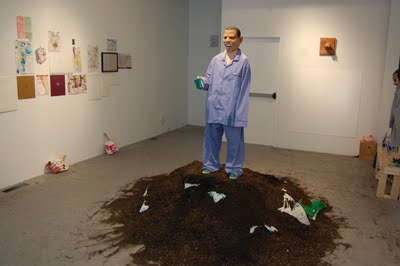 Related:
Related:The last few months have seen a small flurry of writing by other folks about Yokelism. I’ve been meaning to comment in depth, however other obligations have kept me from doing so yet. But the essays are all worth checking out. In addition to
Einspruch and
Petrovich’s essays, Edgar Allen Beem wrote a Dec. 22 essay on
“Yokelism & the Dangers of Provincialism: The Greg Cook-Sebastian Smee Dialogue” at YankeeMagazine.com and Kyle Chayka has written three essays –
“Sourcing Local for Boston Art” (Jan. 26),
“Rebooting Boston’s Art Inferiority Complex” (Feb. 3) and
“A Better Boston: Artists’ Perspectives” (Feb. 11) – at the New York art website Hyperallergic. Also Joel Brown commented on Yokelism at HubArts.com on Feb. 12: “His ideas are good, although
I'm not sure he's chosen the most effective moniker for the movement he's trying to start.”
On Oct. 7, 2009, Real Art Ways in Hartford teamed up with WNPR's "Where We Live" radio show to present a live on-air discussion entitled
"Locating Creativity: Can Art and Innovation Revitalize Hartford?" The organizers produced a short
blog, which includes a recording of the event. The blog also offers a thoughtful post by Real Art Ways Executive Director
Will K. Wilkins, in which he argued:
"It isn’t about one big thing. It’s about an ecosystem of organizations, businesses, artists, activists and entrepreneurs. Hartford is a city that has made some dramatically bad development decisions, ideas that perhaps seemed forward thinking at the time. What those decisions have in common is a search for a 'big bang,' the big project that will be the spark that makes other things happen. It is past time to think differently about development, to recognize the significance of the local, the already existing, the modest, the creative, the idiosyncratic."
And out in Seattle, Jen Graves started a Yokelist-type discussion with her April 7, 2009, essay
"The Vancouver Problem: Why is Vancouver art so much better than art here? A rant to get the conversation started" in The Stranger. Blogger
Regina Hackett responded to Graves on April 14, 2009.
Previously:Yokelist Manifesto Number 1:
Boston lacks alternative spaces?
Yokelism at the
2008 Boston Art Awards.
Yokelist Manifesto Number 2:
Montreal case study.
Yokelist Manifesto Number 3:
Hire locally.
Yokelist Manifesto Number 4:
We need coverage of our living artists.
Yokelist Manifesto Number 5:
We need local retrospectives.
Yokelism update: Coverage of our living artists:
Sebastian Smee responds.
Yokelism update:
Dangers of Provincialism.
Yokelism update:
Re: Dangers of Provincialism.
Yokelist Manifesto Number 6:
Could the CIA help?
Yokelism at the
2009 New England Art Awards.
Pictured: William Pope.L performance and installation at Samson Projects in Boston, as photographed by The New England Journal of Aesthetic Research on March 20, 2010.





